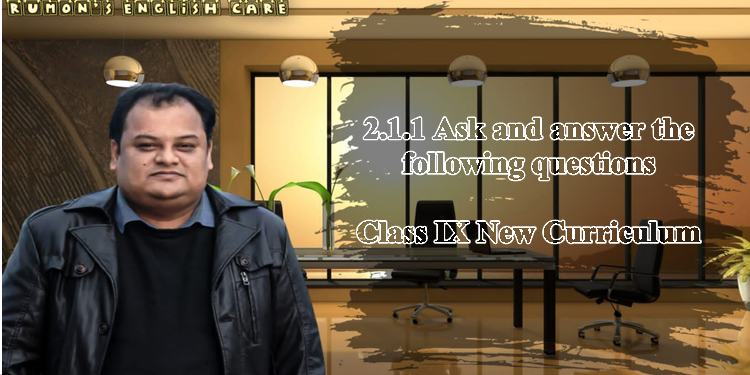2.1.2 Ask and answer the following questions in pairs
2.1.2 Ask and answer the following questions in pairs. Then, share your responses with the class.
a) Do you love nature?
b) Have you read any poem on nature?
c) How does the poet depict nature in the poem?
d) Does he use any literary elements like rhyming scheme, images or
metaphor to describe nature?
e) Do you think the use of literary elements make the poem interesting?
Answers:
(a) Yes, of course. I love nature and who else wouldn’t be nature lover. Nature gives us more than we ever ask for. I love to go to the depth of the nature.
(b) Yes, I have read a poem on nature and that is the poem “Daffodils,” also known as “I Wandered Lonely as a Cloud,” written by William Wordsworth.
Daffodils
by William Wordsworth
I wandered lonely as a cloud
আমি একাকী ঘুরে বেড়াচ্ছি মেঘের মত
That floats on high o’er vales and hills,
যা ভেসে চলে পাহাড় আর উপত্রকার উপর দিয়ে,
When all at once I saw a crowd,
তখনই হঠাৎ আমি দেখি একটি ভিড়,
A host, of golden daffodils;
অসংখ্য সোনালি ড্যাফোডিল আর এই বিশাল বাহিনী
Beside the lake, beneath the trees,
হ্রদের পাশে, বৃক্ষতলে,
Fluttering and dancing in the breeze.
নেচে বেড়াচ্ছে, মৃদু বাতাসে দোল খেয়ে।
Continuous as the stars that shine
যেন বিরতীহীন তারকার উজ্জ্বলতা
And twinkle on the milky way,
যারা মিটমিট করে জলে আকাশের ছায়াপথে,
They stretched in never-ending line
তারা ছড়ানো ছিল দিগন্তহীন লাইনে
Along the margin of a bay:
উপসাগরের কিনারা ঘেষে
Ten thousand saw I at a glance,
এক দৃষ্টিপাতেই আমি দেখিছলাম হাজার দশেক,
Tossing their heads in sprightly dance.
তারা মাথা দোলাচ্ছিল আন্দপূর্ণ
The waves beside them danced, but they
ঢেউ এর নাচন দেখি আমি তাদের পাশে, কিন্তু তারা
Out-did the sparkling waves in glee:
ছাড়িয়ে গেছে ঝিকমিক ঢেউ-এর আনন্দকেও;
A poet could not be but gay,
কোনো কবিই আনন্দিত না হয়ে পারে না,
In such a jocund company:
এরকম আনন্দের সঙ্গী পেয়ে;
I gazed’and gazed’but little thought
আমি চিন্তা না করেই একদৃষ্টিতে তাকিয়ে ছিলাম,
What wealth the show to me had brought:
কী ঐশ্বের্যর প্রদশনী এনেছিল আমার কাছে।
For oft, when on my couch I lie
প্রায়ই যখন, আমি বিশ্রাম নেই
In vacant or in pensive mood,
শুন্য মনে অথবা চিন্তামগ্নভাবে,
They flash upon that inward eye
তারা ভেসে ওঠে অন্তরের চোখে,
Which is the bliss of solitude;
মনে হয় একাকীত্বের নির্মল আনন্দ,
And then my heart with pleasure fills,
আর হৃদয় আনন্দে পরিপূর্ণ হয়ে ওঠে,
And dances with the daffodils.
এবং নেচে ওঠে ড্যাফোডিলের সাথে।
(c) Throughout this poem, the speaker is admiring the natural word and its beauty. The speaker uses beautiful natural imagery to appreciate the beauty of nature.
(d)Wordsworth vividly describes the beauty of nature using rich and imaginative language. Here are some keys ways in which nature in depicted in the poem.
(i) Visual imagery in the poem Daffodils is:
- A host of golden daffodils;
- Besides the lake, beneath the trees,
- Fluttering and dancing in the breeze
(ii) Simile in the poem Daffodils is:
“I wandered lonely as a cloud
That floats on high o’er vales and hills,”
In these lines, Wordsworth compares himself to a cloud using the word ‘as’, creating a simile. He compares his loneliness with a single cloud.
(iii) Metaphor in the poem Daffodils is :
Wordsworth uses one metaphor in this poem in the line “They flash upon that inward eye.” Here ‘inward eye’ represents the sweet memory of daffodils.
(iv) Personification:
The poet has personified “Daffodils’ in the third line of the poem, such as, “When all at once I saw a crowd.” Here “Crowd” shows the number of daffodils.
Additional Task: Need to Know
(1) Visual Imagery: Visual imagery is a literary device that enables writers to create mental images and pictures in the minds of readers. The use of imagery makes the reader visualize the writer’s feelings and emotions.
(2) Simile: Simile is a device used to compare one object to another using ‘as’ or ‘like’
(3) A metaphor is a figure of speech that involves comparing two unlike things by starting that one thing is another. Similes use the words ‘like’ or ‘as’ to make comparisons whereas metaphors compare one thing to another thing without using the words ‘like’ or ‘as’.
Example: Happiness is a warm blanket.
In this metaphor, happiness is directly equated to warm blanket. The comparison implies that hap[piness, like a warm blanket, provides comfort, security, and a sense of well-being.
(4) Personification: Personification is to attribute human characteristics to lifeless objects.
Example: “happiness danced through the room.” In this personification, happiness is given human-like qualities. It described as if it can dance.

